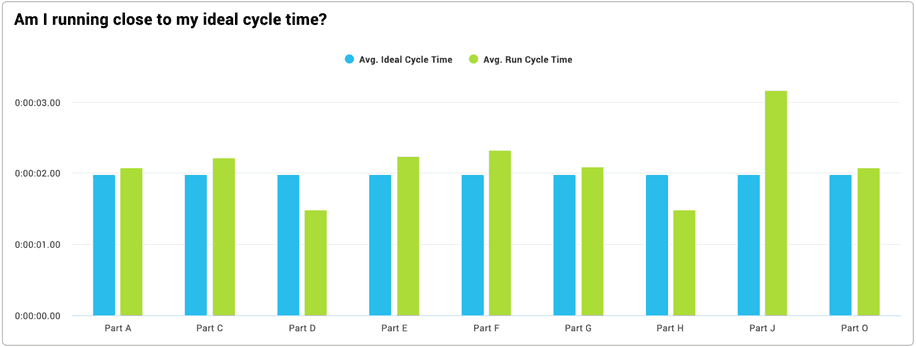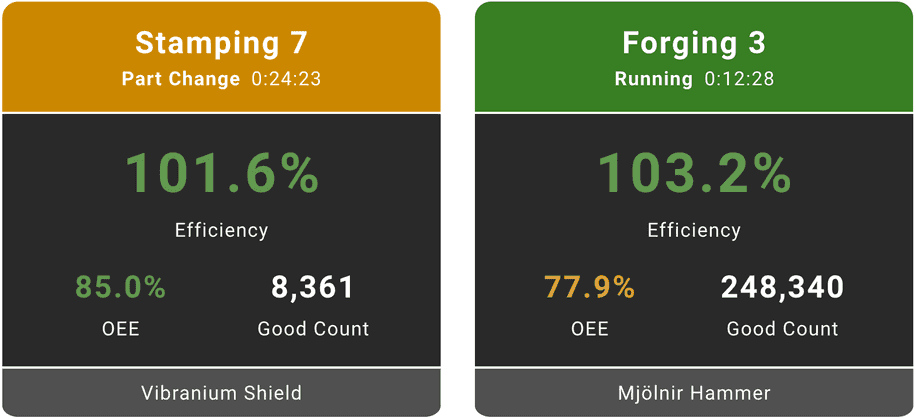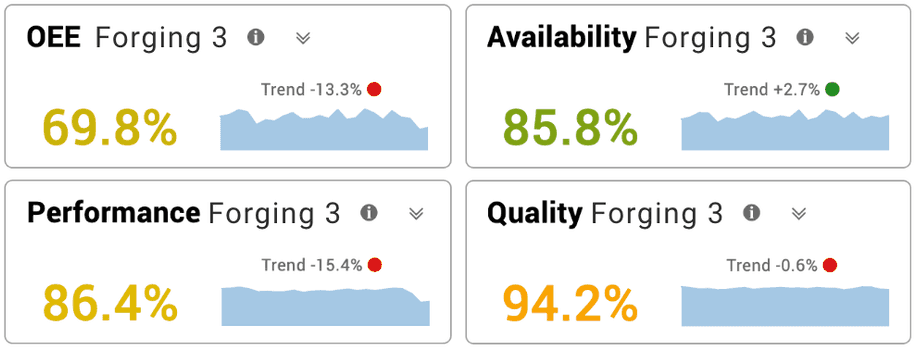Practical OEE

OEE Fundamentals
Let's start with some OEE fundamentals. OEE measures how close you are to perfect production (manufacturing only good parts, as fast as possible, with no down time). It’s calculated from three underlying factors: Availability, Performance, and Quality.
- An Availability score of 100% means the process is always running during planned production time (it's never down). The losses that impact Availability include downtime, changeovers, and maintenance.
- A Performance score of 100% means when the process is running it is running as fast as possible (every cycle at the Ideal Cycle Time). The losses that impact Performance include slow cycles and small stops.
- A Quality score of 100% means there are no defects (only good parts are produced). The losses that impact Quality include all forms of rejects that occur during the first manufacturing pass (including parts that can be reworked).
OEE is calculated by multiplying the three factors.

The Biggest OEE Mistake
By far the most common mistake we see with OEE implementations is inaccurate Ideal Cycle Times. For example, many companies use ‘budget’ or ‘standard’ speeds that are slower than the Ideal Cycle Time. Doing so inflates OEE, hides loss, and underestimates the true throughput of the process.
Ideal Cycle Time (or ICT) is the theoretical maximum throughput of the process. It should not be lowered due to factors such as machine age or material quality. Instead, these types of loss factors should be seen as opportunities for improvement.
Two common approaches to determining Ideal Cycle Time are:
- Nameplate Capacity: This is the value that the equipment builder specifies (e.g., you may buy a press with a design capacity of 120 strokes per minute).
- Time Study: Measure the absolute fastest speed that the process can support (not an average or normal speed). Be careful not to include any form of speed loss (i.e., slow cycles or small stops).
Here is a fun exercise! Can you identify which parts below have an inaccurate ICT? If your answer is Part D and Part H - you are exactly right. An Ideal Cycle Time that is higher than the Run Cycle Time is set too high. In the real world, we see this problem all the time.
What about Part J? It may simply be a part that ran poorly with a lot of slow cycles. However, it may also be a part where the ICT is set too low. As an outlier it is definitely worth a bit of investigation.
The OEE Score
What is a good OEE score?
Let’s start with what it’s not. It is not an arbitrary number like the frequently cited 85% world-class OEE. Instead, a good OEE score is one that is consistently improving. Determine your baseline OEE score and focus on steadily and incrementally improving from that point. We can’t emphasize this enough. It’s about percentage improved - NOT percentage achieved.

We recommend that you accurately determine your OEE baseline for each process and set targets that drive meaningful and incremental improvement. Each step should be a stretch target that is achievable within a couple of months. Short enough to keep people engaged, long enough to achieve significant improvement.
This is effectively an agile approach to improvement. Agile is by nature incremental - breaking large tasks, goals, and projects into small deliverables. The principles of agile apply very well to manufacturing improvement projects and OEE.
One more tip - let OEE be a brutal measure. It’s okay to wince a little when you see your “true” OEE score. See it as an opportunity. A lot of companies exclude bits and pieces of time from OEE - all with very reasonable justifications. Don’t give into temptation. The more losses that are exposed, the more fertile ground you’ll have for improvement.
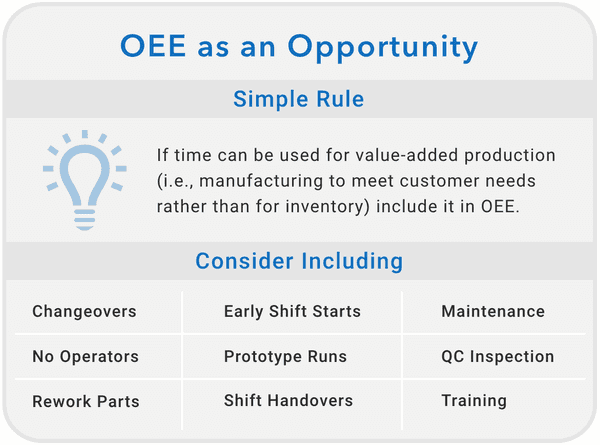
OEE as an Effective Tool
Why measure OEE?
It is easy to get so focused on your OEE score that you lose sight of why you are measuring it. Think of OEE as a tool to further your business goals. Usually that means focusing less on the OEE score and more on the underlying OEE losses. Monitoring OEE on its own is not all that helpful to improving production.
Let’s look at monitoring OEE from three perspectives - operator, supervisor, and loss.
From an operator perspective - OEE is a somewhat abstract measure. While you certainly can set an OEE target for operators and even monitor it in real time, an excellent alternative is to focus on Efficiency (measured as the ratio of Good Count to Target Count). The benefit of Efficiency is that it enables operators to “win their shift” by achieving 100% of their target (i.e., 100% Efficiency). This is a very powerful motivator – especially when operators can see their Efficiency score in real time.
Another benefit of focusing on Efficiency is that it is calculated from Takt Time. This enables setting an explicit target for operators, while management keeps their focus on the true capabilities of the process based on Ideal Cycle Time.
From a supervisor perspective - OEE is a very useful top-level analytical tool, especially when viewed as a trend that shows whether or not the process is improving over time. As an analytical tool, it is very important to break OEE into the three underlying factors: Availability, Performance, and Quality. These three factors are the bridge to understanding the underlying losses that impact OEE.
From a loss perspective - OEE is the starting point for taking action. Your OEE score tells you where you are at - but not what you need to do to improve. The real power and the true value of OEE comes from understanding and acting on the underlying losses: Availability Loss, Performance Loss, and Quality Loss. Take effective action to reduce these losses and your top-level OEE score will naturally improve.
The three types of OEE losses can be mapped to six universal loss categories (also referred to as the Six Big Losses). From there it becomes much easier to apply specific tools and actions to address the losses.
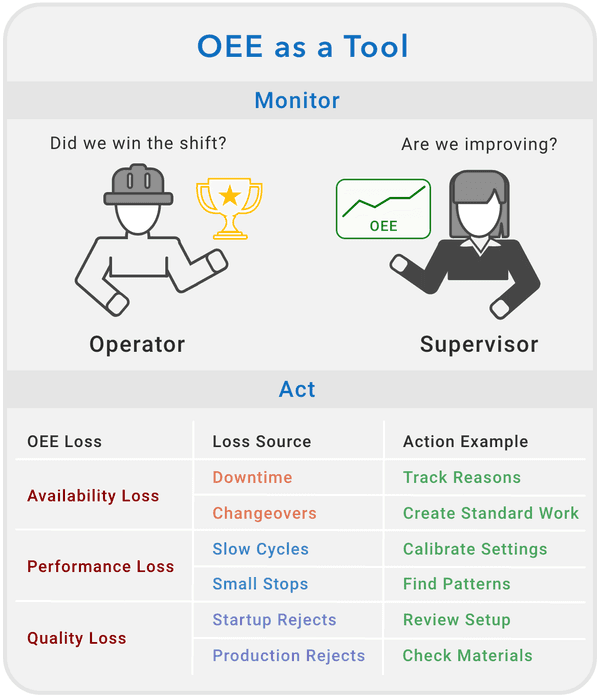
WHAT YOU SHOULD DO NEXT...
1. Learn more about how our product, Vorne XL, can help you eliminate waste and significantly improve OEE.
Vorne XL is the simplest and fastest way to monitor and improve production. It's a one-time cost and takes just a day to install. And you can try it completely free for 90 days.
Learn More2. Download our FREE package of tools to supercharge your manufacturing productivity
The package includes leadership lessons, training guides, meeting and report templates, summaries of key concepts, project organizers, and more. You'll also receive our monthly newsletter for free. Unsubscribe at any time.
DOWNLOAD FREE LEAN TOOLS3. Sign up for our monthly newsletter
Get free monthly updates with proven methods for improving our manufacturing productivity. Unsubscribe at any time.

